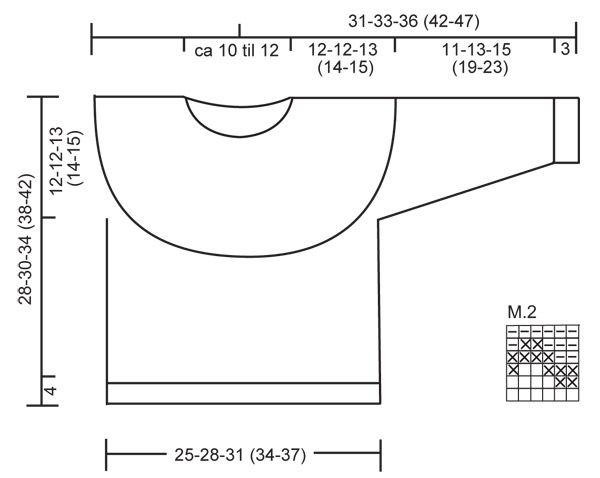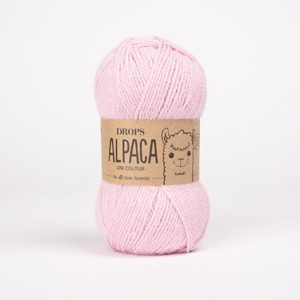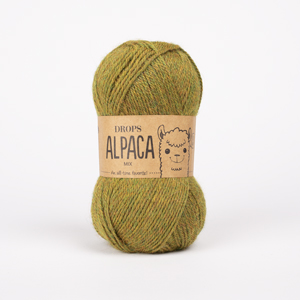Comments / Questions (56)
![]() Inge wrote:
Inge wrote:
Det er lige netop det jeg ikke forstår med de 22 masker. I diagrammet er der 2x11 masker. Det er vel ikke de 11 masker der skal gentages indtil delingen. Håber I kan forklare det så jeg kan forstå det. Hilsen Inge og på forhånd tak
07.01.2025 - 15:55DROPS Design answered:
Hei Inge. Det er bare 1 diagram og det består i begynnelsen av 24 masker. På pinne 11 felles det 2 masker hver gang du strikker diagrammet og diagrammet består nå av 22 masker. På pinne 19 felles det 2 masker i diagrammet og nå består diagrammet av 20 masker osv. Siste pinne i diagrammet består av 10 masker. Selv om diagrammet deles i to, strikkes det som 1 diagram. mvh DROPS Design
13.01.2025 - 11:39
![]() Inge wrote:
Inge wrote:
Mht delingen af bærestykket kan jeg ikke blive klog på hvordan det forholder sig i forhold til mønsterdiagrammet. I diagrammet er det to sider med 11 masker i hver side til at starte med. Det ser da ikke rigtigt ud hvis det er disse 11 masker der skal gentages pinden/siden ud.
03.01.2025 - 11:22DROPS Design answered:
Hei Inge. Etter delingen og når du starter å strikke M.1 består diagrammet av 24 masker. Det er 192-216-240-264 eller 288 masker på pinnen og man strikker M.1 8-9-10-11 eller 13 ganger. Man strikker 10 omganger der diagrammet har 24 masker. På 11. omgang felles det 2 masker pr gang diagrammet strikkes = 176-198-220-242 eller 264 masker på pinnen. Nå består M.1 av 22 masker. mvh DROPS Design
07.01.2025 - 13:32
![]() Balsan Jacquie wrote:
Balsan Jacquie wrote:
Je voudrais connaître l'astuce pour éviter le décalage des rayures quand on tricote en rond. Merci pour le conseil
02.11.2024 - 13:08DROPS Design answered:
Bonjour Mme Balsan, retrouvez cette astuce en vidéo ici. Bon tricot!
04.11.2024 - 08:11
![]() Linda Mikkelsen wrote:
Linda Mikkelsen wrote:
Jeg vil strikke Sguirrel song. Jeg har skrevet ud opskrift. Så forsøger jeg at bedstille garn fra samme side, men jeg kan ikke finde andet end F. Nr 100, natur? Hvor kan jeg købe garn fargene til denne trøye?
06.08.2024 - 22:57DROPS Design answered:
Hej Linda, jo hvis du klikker på Bestil inde på selve opskriften, så kommer du ind på butikkens farvekort og så er det bare at vælge de farver du vil strikke den i :)
08.08.2024 - 15:13
![]() Sandra San Martín Stenger wrote:
Sandra San Martín Stenger wrote:
Existe algún vídeo que pueda ver, me es mucho más fácil de seguir y comprender, se los agradecería mucho. Gracias!!!
02.10.2022 - 03:46DROPS Design answered:
Hola Sandra, todos los vídeos que pueden ayudarte a realizar la labor se encuentran en la sección de videos, bajo las instrucciones del patrón.
02.10.2022 - 23:51
![]() Catherine wrote:
Catherine wrote:
Bonjour, peut-on faire ce modèle sans les deux bandes de boutonnière ? ( col tricoté en rond )
08.02.2022 - 15:29DROPS Design answered:
Bonjour Catherine, il est possible que l'encolure soit alors trop serrée, vérifiez en fonction de votre tension/du tour de tête de l'enfant si le pull est susceptible de passer et ajustez si besoin. Bon tricot!
08.02.2022 - 16:05
![]() Angela wrote:
Angela wrote:
Onko olkapäälle tulevasta nappilistasta ohjevideota? Tai ohjekuvia?
02.01.2022 - 09:24DROPS Design answered:
Valitettavasti kyseistä kuvaa tai ohjevideota ei juuri nyt löydy.
09.03.2022 - 17:07
![]() Kirsi Maaniemi wrote:
Kirsi Maaniemi wrote:
Hei, en ymmärrä kuinka nappilistahalkio tehdään. Olisiko siitä kuvia?
19.12.2021 - 22:48DROPS Design answered:
Nappilista tehdään siten, että työ jaetaan keskeltä takaa ja kerroksen loppuun luodaan 3 uutta silmukkaa. Jatkossa kummankin reunan reunimmaisilla 3 silmukalla neulotaan ainaoikeaa pohjavärillä.
07.03.2022 - 17:16
![]() Rhonda Ellis wrote:
Rhonda Ellis wrote:
How don't understand how to do the split for the Squirrel Song pattern. can you please help me with this. do I continue on in the round but don't join the piece? I'm so confused.
02.12.2021 - 17:35DROPS Design answered:
Dear Mrs Ellis, for the split mid back you will then work like this at the required height: at the end of the round (mid back), cast on 3 sts (button band), turn and work now from WS (from WS read now diagram from the left towards the right) until 3 sts remain before the end of the row, and work the last 3 sts in garter stitch. Turn and work now from RS again. Continue like this alternately from RS and from WS with 3 sts in garter stitch on each side. Happy knitting!
03.12.2021 - 07:58
![]() Samia wrote:
Samia wrote:
Bonjour, au moment où on est sur l'empiècement: on est sur les aiguilles circulaires, et là on est sensé faire l'ouverture du dos, du coup ça veut dire qu'on fait le tricot en aller/retour à la place de tout en rond, avec des aiguilles circulaires? merci pour votre aide :)
17.05.2021 - 12:41DROPS Design answered:
Bonjour Samia, effectivement, lorsque l'on divise l'ouvrage pour la fente d'encolure dos, on continue non plus en rond mais en allers et retours, autrement dit, on tricote alternativement sur l'endroit et sur l'envers, avec l'aiguille circulaire - cf vidéo. Bon tricot!
17.05.2021 - 14:09
Squirrel Song#squirrelsongsweater |
||||||||||||||||
 |
 |
|||||||||||||||
Set of knitted jumper with round yoke, squirrel and heart detail, plus socks for baby and children in DROPS Alpaca
DROPS Baby 17-15 |
||||||||||||||||
|
JUMPER: PATTERN: See diagram M.1 – the entire pattern is worked in stocking st. GARTER ST (back and forth on needle): K all rows. ---------------------------------------------------------- BODY PIECE: Worked in the round on circular needle. Cast on 148-168-184 (204-220) sts on circular needle size 2.5 mm with beige. Work 4 cm rib, K2/P2. Continue in stocking st, AT THE SAME TIME dec 18-22-24 (28-30) sts evenly on first round = 130-146-160 (176-190) sts. REMEMBER THE KNITTING TENSION! When piece measures 16-18-21 (24-27) cm work next round as follows: cast off 8 sts for armhole, work 57-65-72 (80-87) sts = front piece, cast off 8 sts for armhole, work 57-65-72 (80-87) sts = back piece. Put piece aside and knit the sleeves. SLEEVE: Worked in the round on double pointed needles. Cast on 40-44-48 (52-56) sts on double pointed needles size 2.5 mm with beige and work 3 cm rib, K2/P2. Continue in stocking st, AT THE SAME TIME on first round dec 4-6-8 (10-12) sts evenly = 36-38-40 (42-44) sts. Insert a marker at beg of round = mid under arm. When piece measures 4-4-4 (5-5) cm inc 1 st on each side of marker and repeat the inc on every 5-5-5 (6-6) round a total of 7-8-9 (10-12) times = 50-54-58 (62-68) sts. When piece measures 14-16-18 (22-26) cm cast off 8 sts mid under arm (= 4 sts on each side of marker) = 42-46-50 (54-60) sts. Put piece aside and knit the other sleeve. YOKE: Slip sleeves on the same circular needle size 2.5 mm as body piece where cast off for armholes = 198-222-244 (268-294) sts. Round now beg mid back. Work 1-1-3 (7-10) rounds beige, AT THE SAME TIME on first round dec 6-6-4 (4-6) sts evenly = 192-216-240 (264-288) sts. Now continue in M.1 – AT THE SAME TIME when piece measures 24-26-30 (34-38) cm divide piece mid back for split as follows: Work round to mid back, cast on 3 new sts (= right buttonhole band), turn piece and now work all sts back and forth on needle with 3 garter sts each side for buttonhole bands (work the inc 3 sts in main colour). AT THE SAME TIME after 2 cm make 1 buttonhole on left buttonhole band by K tog 2nd and 3rd st from edge and make 1 YO. After M.1 there are 83-93-103 (113-123) sts on row and piece measures approx 28-30-34 (38-42) cm. Work 1 row stocking st, AT THE SAME TIME adjust no of sts to 72-76-80 (84-88). K 4 rows and continue as follows from RS: 3 garter sts, * K2, P2 *, repeat from *-*, and finish with K2 and 3 garter sts. When rib measures 1-1-1 (1.5-1.5) cm make 1 buttonhole in line with the other on buttonhole band and repeat when rib measures 3-4-4 (4.5-4.5) cm. Cast off when rib measures 4-5-5 (6-6) cm. ASSEMBLY: Fold rib double towards WS at neckline and fasten. Sew openings under arms. Sew on buttons to fit buttonholes. ---------------------------------------------------------- SOCKS: HEEL DECREASES: Row 1 (= RS): Work row until 6-6-6 (7-8) sts remain, slip next st as if to K, K1, psso, turn piece, Row 2 (= WS): Work row until 6-6-6 (7-8) sts remain, slip next st as if to P, P1, psso, turn piece, Row 3 ( = RS): Work row until 5-5-5 (6-7) sts remain, slip next st as if to K, K1, psso, turn piece, Row 4 (= WS): Work row until 5-5-5 (6-7) sts remain, slip next st as if to P, P1, psso, turn piece. Continue dec like this with 1 less st between each dec until there are 8-10-10 (10-12) sts on row. PATTERN: See diagram M.2 – the entire diagram is worked in stocking st. DECREASING TIP: Dec as follows before marker: K2 tog. Dec as follows after marker: slip 1 st as if to K, K1, psso. ---------------------------------------------------------- SOCK: Worked in the round on double pointed needles. Cast on 44-48-48 (52-56) sts on double pointed needles size 2.5 mm with beige. Work 5-5-6 (6-7) cm rib, K2/P2, and then K 1 round, AT THE SAME TIME dec 8 sts evenly = 36-40-40 (44-48) sts. Now keep the first 18-20-20 (22-26) sts on needle for heel and slip the remaining 18-20-20 (22-22) sts on a stitch holder = upper foot. Work 3-3.5-4 (4-4.5) cm stocking st on heel sts. Insert a marker in piece and now dec for heel – SEE ABOVE. After heel dec pick up 8-9-10 (10-11) sts on both sides of heel and slip sts from stitch holder back on needles = 42-48-50 (52-56) sts. Continue in stocking st, AT THE SAME TIME dec 1 st before the 18-20-20 (22-22) sts on upper foot by K2 tog and 1 st after the 18-20-20 (22-22) sts upper foot by K2 tog into back of loop. Repeat the dec on every other round a total of 3-6-7 (5-7) times = 36-36-36 (42-42) sts. When piece measures 6-7-8 (10-12) cm from marker on heel work M.2. Now insert a marker each side with 18-18-18 (22-22) sts on upper foot and 18-18-18 (20-20) sts under foot. Continue in off-white, AT THE SAME TIME dec 1 st on each side of both markers – SEE DECREASING TIP - on every round 7-7-7 (8-8) times = 8-8-8 (10-10) sts left. Cut the thread, pull through remaining sts and fasten. Sock measures approx 10-11-12 (14-16) cm. |
||||||||||||||||
Diagram explanations |
||||||||||||||||
|
||||||||||||||||

|
||||||||||||||||

|
||||||||||||||||
Have you finished this pattern?Tag your pictures with #dropspattern #squirrelsongsweater or submit them to the #dropsfan gallery. Do you need help with this pattern?You'll find 22 tutorial videos, a Comments/Questions area and more by visiting the pattern on garnstudio.com. © 1982-2025 DROPS Design A/S. We reserve all rights. This document, including all its sub-sections, has copyrights. Read more about what you can do with our patterns at the bottom of each pattern on our site. |
||||||||||||||||

































































Post a comment to pattern DROPS Baby 17-15
We would love to hear what you have to say about this pattern!
If you want to leave a question, please make sure you select the correct category in the form below, to speed up the answering process. Required fields are marked *.